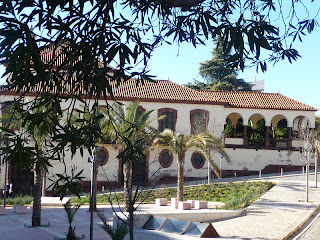Algarve's fertile soil and strategic hills and rivers atracted visitors since the time of the Phoenicians. In fact, I was surprised to learn that Portugal is one of the oldest nation states in Europe, founded in 1139 with borders not much changed since then. The other fact that I found impressive was that such a small country could have had such a golden age of discoveries, leading to colonies much bigger than itself.
The Romans, who arrived in 216BC, were followed by Germanic tribes, followed by the Moors, whose influence of 500 years are still very visible in Portugal's architecture and who were driven out during the military reonquest by the Christian kingdoms of the north.
We didn't explore a big area in Algarve, as the main aim was to be tranquil during our week's stay in Sao Rafael, but we did visit two villages not too far - Silves and Alte.
Silves, being on a hillside surrounded by a fertile valley, was chosen by the Romans to build a fortified castle. But it was under the Moors that the village flourished, becoming the Moorish capital and renowned as a cultural centre for the Moors, home to poets and others.
Until the 15th-c when the river silted up, Silves was a prosperous port. Today the main activity is the oranges and lemons that grow in abundance in the region. It was a beautiful sight to pass these trees, full of ripe oranges and lemons. We've passed a packhouse where one could see some activity as they are getting ready for the upcoming harvest season.
This church reminding JL of a church he saw in Brazil. Clearly the influence of the Portugal architecture on its former colony.
Just behind the church and next to the castle, we found a welcoming restaurant where we had a pizza and nachos for lunch.
The entrance to the castle:
The view from the castle
One of the fascinating features of the castle is the Cisterna da Moora Encantada, the cistern of the enchanted moor. Built by the Moors in the 12th/13th-c, it can house 1.3 million litre of water. They have built it to sustain the population during a siege. Below you can see an exhibition board, showing wheels on the castle walls, helping to draw water up to the cistern.
A village square
Above: another interesting building
Below: from Silves we went to Alte, suppose to be one of the prettiest villages in the Algarve, but we were a bit disappointed. I suppose it might be different in summer, but we found it a ghost town and a bit dirty and neglected, whereas other villages are really very clean and well maintained. We gave up on being served for a coffee and left, after a walk through the village.
Above: the coffee shop is also a gift shop, selling some of the pottery the region is famous for












No comments:
Post a Comment